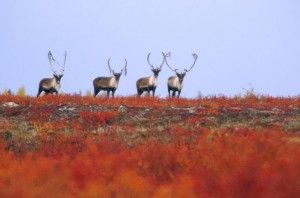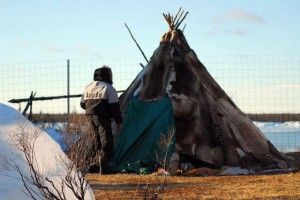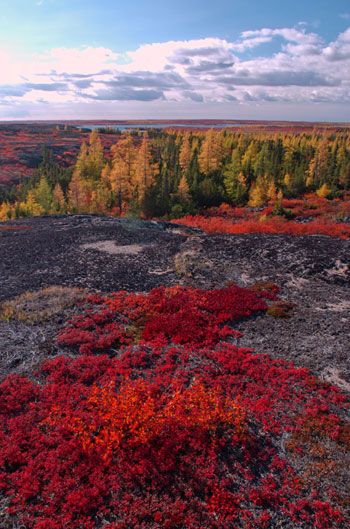by Rick Kemp
With the launch of the Churchill Wild Arctic Safari we are excited to be featuring something we have wanted to give our guests for over a decade – a fly out to witness a stunning caribou migration and a chance to experience Canadian arctic wildlife at its finest, all while immersed in a kaleidoscope of fabulous fall colors!
Churchill Wild’s polar bear tours will never be the same!
Polar bears are always the marquee stars of any Churchill Wild adventure but equal billing for the Arctic Safari can surely go to the caribou of the Qamanirjuaq herd. The Qamanirjuaq caribou herd (ka-min-YOO-ree-ak) is estimated to be between 300,000 to 400,000 strong, and Churchill Wild has located the perfect spot on the migration route to witness this stunning spectacle.
The Qamanirjuaq continues to have strong numbers, despite population declines in other major caribou herds in Canada’s North. The total area used by the herd during their migration spans more than 500,000 square kilometers north to south along the Hudson Bay’s west coast. The winter range primarily consists of forested lands in northern Manitoba and tundra in Manitoba and Nunavut.
In Inuit mythology Tekkeitsertok is the master of caribou, one of the most important gods in the pantheon. Many Dene and Inuit historically depended on caribou for food, clothing and shelter; so much so that the Inuit of the area were given the name “Caribou Eskimo” by early European explorers.
The Inuit survived by hunting and trapping in family groups while living in what is now Nunavut and Northern Manitoba. Although apprehensive for many generations, they began trading regularly with the Europeans in the early 1900s and by the late 1950s were moving into communities. They were encouraged by government to do this so their children could attend school and have access to medical care.
Today, the Qamanirjuaq caribou continue to be very important in maintaining the culture and traditional lifestyles of Dene, Métis, and Inuit across the north by providing food, materials for traditional clothing, special tools & shelter.
One of the shelters that was traditionally constructed is called a “tupik”. Last fall an Inuit couple named Peter and Mary graciously visited to teach our guests about their culture and their way of life during the Great Ice Bear Adventure at Dymond Lake Ecolodge. Peter and Mary built the tupik to show us what they would live in while traveling and hunting during the summer months in the north. The tupik is constructed of about 20 caribou hides and long skinny timbers.
An Inuit legend about the origin of caribou goes like this:
Once upon a time there were no caribou on the earth. But then there was a man who wished for caribou, and he cut a great hole deep into the ground, and up through this hole came caribou, many caribou. The caribou came pouring out, till the earth was almost covered with them. And when the man thought there were caribou enough for mankind, he closed up the hole again. Thus the caribou came up on earth.
The numbers of caribou seem to be inconsistent but plentiful. Distribution and migration of 10 adult female Qamanirjuaq caribou have been monitored since 1993 using radio-collars and tracked by satellites. The results of this study have provided insight to the herd’s recent distribution and movement patterns.
While Churchill Wild goes to great lengths to preserve the natural habitat we encounter, there are some external threats that are concerning. Hydro transmission lines, roads to communities in northern Manitoba, mineral exploration and mines are all issues local groups have voiced concern with. These activities continue to spread to the calving and post-calving areas. Hydro-electric development could affect movement of the herd during spring and fall migration as they may need to make detours if traditional water crossing sites are impassable due to water level changes from hydro dams.
As a way of addressing these and other concerns the Beverly & Qamanirjuaq Caribou Management Board (BQCMB) was established in 1982 to coordinate management of the herds. The Board’s responsibility is to make recommendations to government and conduct projects for conservation and management of the caribou herds and their habitat.
There are times when a caribou is in the vicinity of one of our lodges and guests are always amazed with their grace. To see one as part of a herd is fascinating and a spectacle we are excited to present as part of our Polar Bear Arctic Safari.
But caribou and polar bears? Together? Polar bears are often said to be the world’s largest land predators and our experienced guides (Andy & Terry) keep the guests safe. What about the caribou?
While there have been very few documented cases of the two species interacting, some observations indicate that polar bears will stalk and chase caribou, but you would not likely witness it during your adventure with Churchill Wild.
Churchill Wild’s polar bear guides have been reporting an increasing number of polar bear sightings on the caribou range, with bears spotted as far as 150 kilometres from the coast in recent years.
Last summer a polar bear found its way as far south as Shamattawa, Manitoba – about 400 kilometres away from the Hudson Bay coast. These instances are extremely rare but the phenomenon could explain the “grolar” or “pizzly” bears (which we will pretty much guarantee you will NOT see!)
Churchill Wild’s Arctic Safari is easily our most ambitious adventure to date and the timing is essential. A small window in early September provides the perfect apex to see the widest variety of wildlife and brilliant displays of the Aurora Borealis.
The Arctic Safari takes you over 20,000 square kilometres of the wildest regions in the Arctic; providing the potential “Big Five” (and then some) of wolves, caribou, moose, three species of bears (polar, black and grizzly), belugas, arctic and colored fox, wolverine, beaver, pine marten, arctic birds and of course, spectacular Northern Lights.
For more information about the Arctic Safari or any of our Arctic Adventure Travel Experiences, please call our office, sign up for our newsletter or e-mail us at info@churchillwild.com. We would love to hear from you!











